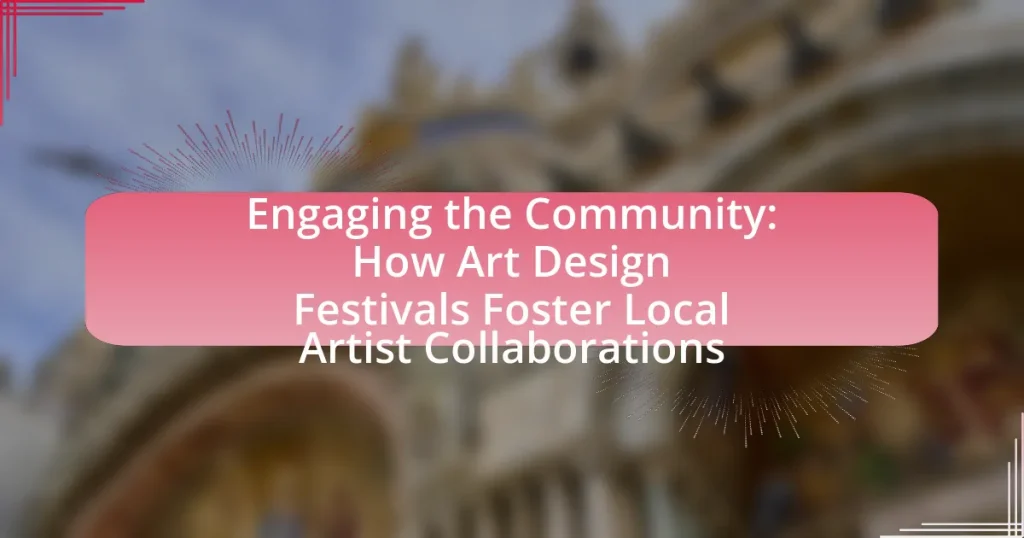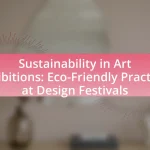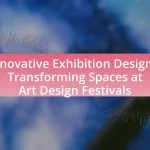Art design festivals are organized events that showcase various forms of art and design, serving to celebrate creativity, promote cultural exchange, and foster community engagement. These festivals provide platforms for local artists to display their work, engage with the public, and collaborate with one another, enhancing both visibility and economic growth within the community. The article explores how these festivals facilitate artist collaborations, promote inclusivity and diversity, and contribute to local economies while strengthening community identity and pride. Additionally, it outlines best practices for organizing successful festivals that effectively involve local artists and encourage community participation.
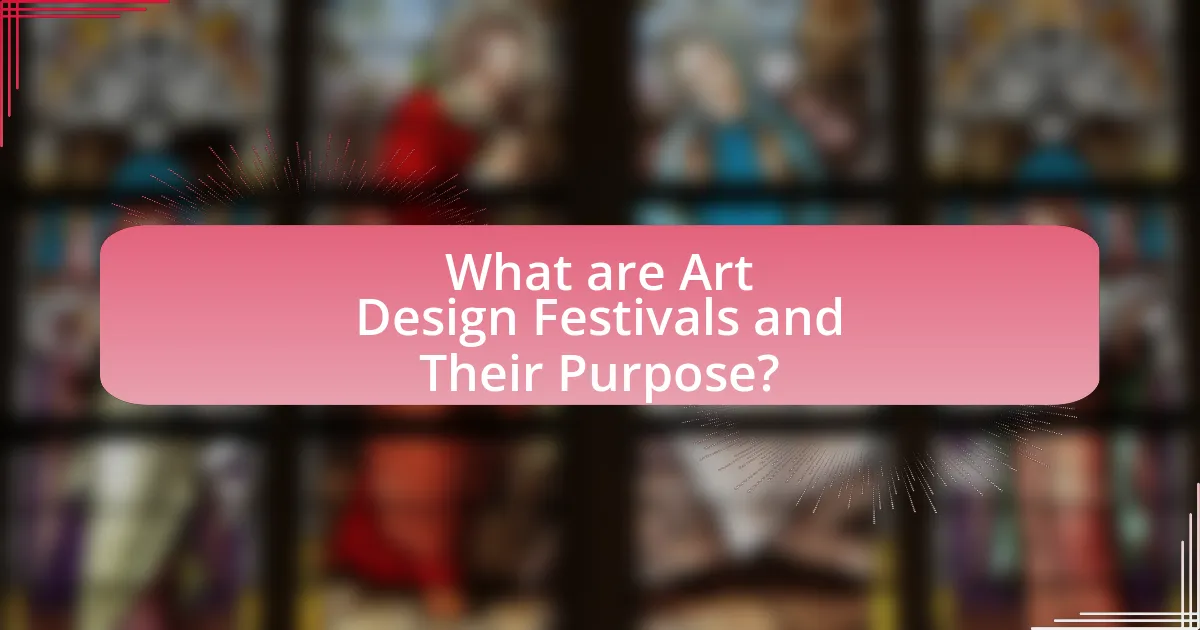
What are Art Design Festivals and Their Purpose?
Art design festivals are organized events that showcase various forms of art and design, including visual arts, fashion, architecture, and multimedia installations. Their primary purpose is to celebrate creativity, promote cultural exchange, and foster community engagement by providing a platform for artists to display their work and connect with the public. These festivals often include workshops, panel discussions, and interactive activities, which encourage collaboration among local artists and enhance community involvement in the arts. For instance, events like the Venice Biennale and the London Design Festival attract international attention while simultaneously supporting local talent and stimulating economic growth in their respective areas.
How do Art Design Festivals engage the community?
Art Design Festivals engage the community by providing a platform for local artists to showcase their work and interact with the public. These festivals often include workshops, panel discussions, and interactive installations that invite community participation, fostering a sense of ownership and connection to the art. For example, festivals like the Venice Biennale and Art Basel have been known to incorporate local artists into their programming, which not only highlights regional talent but also encourages community members to engage with the art in meaningful ways. This engagement is further supported by the economic boost these festivals provide to local businesses, creating a symbiotic relationship between the arts and the community.
What role do local artists play in these festivals?
Local artists serve as vital contributors to festivals by showcasing their work, enhancing cultural representation, and fostering community engagement. Their participation not only highlights regional talent but also creates a platform for collaboration and networking among artists and attendees. Festivals often feature local artists through exhibitions, performances, and workshops, which can lead to increased visibility and opportunities for these creators. For instance, a study by the National Endowment for the Arts found that local artist involvement in community events significantly boosts local economies and strengthens community ties.
How do festivals promote cultural exchange within the community?
Festivals promote cultural exchange within the community by providing a platform for diverse cultural expressions and interactions. These events often feature performances, art displays, and culinary experiences from various cultural backgrounds, allowing attendees to engage with and appreciate different traditions. For example, the annual International Festival in cities like Toronto showcases over 200 cultural groups, facilitating dialogue and understanding among participants. This interaction fosters a sense of community and belonging, as individuals share their heritage and learn from one another, ultimately enriching the local cultural landscape.
Why are collaborations important for local artists?
Collaborations are important for local artists because they enhance creativity and expand exposure. By working together, artists can combine their unique skills and perspectives, leading to innovative projects that may not be possible individually. Additionally, collaborations often attract a wider audience, as each artist brings their own followers, thereby increasing visibility and potential sales. Research indicates that collaborative projects can lead to a 30% increase in audience engagement at art festivals, demonstrating the tangible benefits of such partnerships.
What benefits do local artists gain from collaborating at festivals?
Local artists gain increased visibility and networking opportunities from collaborating at festivals. By participating in these events, artists can showcase their work to a broader audience, which can lead to potential sales and commissions. Festivals often attract diverse crowds, providing artists with the chance to connect with other creatives, industry professionals, and art enthusiasts. This collaboration can also foster skill-sharing and mentorship, enhancing their artistic development. Additionally, festivals can create a sense of community, allowing artists to build relationships that may lead to future collaborative projects or exhibitions.
How do collaborations enhance the artistic quality of the festivals?
Collaborations enhance the artistic quality of festivals by integrating diverse perspectives and skills from various artists, which leads to innovative and multifaceted artistic expressions. When artists from different backgrounds collaborate, they combine their unique techniques and ideas, resulting in a richer and more dynamic festival experience. For instance, a study by the National Endowment for the Arts found that collaborative projects often yield higher levels of creativity and audience engagement, as they reflect a broader range of cultural narratives and artistic styles. This synergy not only elevates the overall aesthetic of the festival but also fosters a sense of community and shared purpose among participants and attendees.
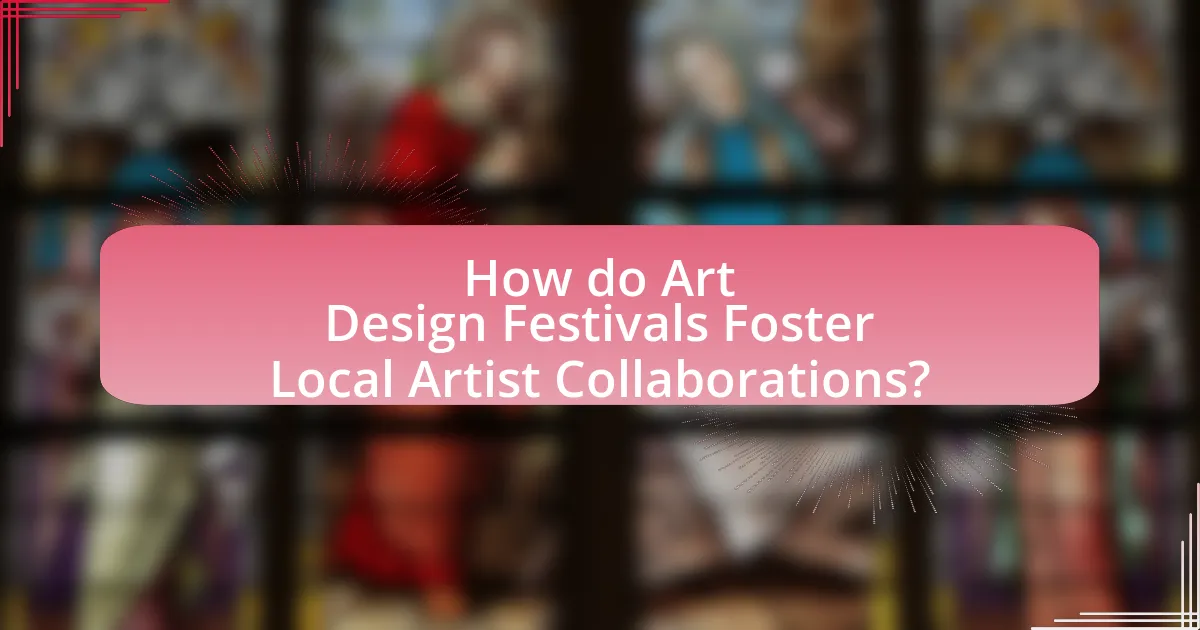
How do Art Design Festivals Foster Local Artist Collaborations?
Art design festivals foster local artist collaborations by providing a platform for networking, showcasing talent, and facilitating joint projects. These festivals create an environment where artists can meet, share ideas, and collaborate on creative endeavors, often leading to innovative works that reflect the local culture. For instance, events like the Venice Biennale and Art Basel have historically encouraged partnerships among local artists, resulting in community-driven art installations and exhibitions that enhance cultural dialogue. Such collaborations not only elevate the visibility of local artists but also strengthen community ties and promote cultural exchange.
What types of collaborations occur during these festivals?
During art design festivals, various types of collaborations occur, including partnerships between local artists, community organizations, and businesses. These collaborations often manifest as joint art projects, workshops, and exhibitions that showcase the talents of multiple artists while engaging the local community. For instance, festivals may feature collaborative installations where artists work together to create large-scale pieces, or they may host workshops that encourage participation from community members, fostering a sense of ownership and connection to the art. Such collaborations not only enhance the festival experience but also strengthen community ties and promote local culture.
How do artists from different disciplines collaborate?
Artists from different disciplines collaborate by integrating their unique skills and perspectives to create multidisciplinary projects. This collaboration often occurs in settings like art and design festivals, where artists from various backgrounds, such as visual arts, music, dance, and theater, come together to produce innovative works. For instance, a visual artist may work alongside a musician to create an immersive installation that combines visual and auditory elements, enhancing the audience’s experience. Such collaborations not only enrich the artistic output but also foster community engagement, as diverse audiences are drawn to the multifaceted nature of the projects. Evidence of this can be seen in festivals like the Edinburgh Festival Fringe, where artists from different disciplines regularly collaborate, resulting in a vibrant exchange of ideas and creativity.
What are some successful examples of artist collaborations at festivals?
Successful examples of artist collaborations at festivals include the 2019 Coachella Valley Music and Arts Festival, where artists like Childish Gambino and Ariana Grande performed together, creating unique live renditions of their hits. Another notable instance is the 2018 Bonnaroo Music and Arts Festival, where the supergroup Superjam featured collaborations among various artists, including members from The Roots and John Mayer, resulting in a dynamic and memorable performance. Additionally, the 2020 Lollapalooza festival showcased a collaboration between Billie Eilish and her brother Finneas, highlighting their synergy and creative partnership. These collaborations not only enhance the festival experience but also foster community engagement and artistic innovation.
How do festivals facilitate networking among local artists?
Festivals facilitate networking among local artists by providing a shared platform for collaboration, exposure, and interaction. These events create opportunities for artists to showcase their work, engage with peers, and connect with potential collaborators, which can lead to future projects and partnerships. For instance, festivals often include workshops, panel discussions, and networking events specifically designed to encourage dialogue and collaboration among artists. This environment fosters relationships that can enhance artistic development and community engagement, as evidenced by studies showing that artists who participate in festivals report increased collaboration and visibility within their local art scenes.
What platforms do festivals provide for artists to connect?
Festivals provide various platforms for artists to connect, including networking events, workshops, and collaborative projects. These platforms facilitate direct interaction among artists, allowing them to share ideas, collaborate on creative endeavors, and build professional relationships. For instance, many festivals host artist panels and discussions that encourage dialogue and exchange of experiences, fostering a sense of community. Additionally, festivals often feature exhibition spaces where artists can showcase their work, attracting attention from peers and potential collaborators. This structured environment not only enhances visibility but also promotes partnerships that can lead to future projects.
How does networking lead to future collaborations?
Networking leads to future collaborations by establishing relationships that facilitate trust and mutual understanding among individuals and organizations. When artists and professionals connect at events like art design festivals, they share ideas, resources, and opportunities, which can lead to joint projects or partnerships. Research indicates that 70% of jobs are found through networking, highlighting its effectiveness in creating collaborative opportunities. Additionally, networking allows for the exchange of diverse perspectives, enhancing creativity and innovation in collaborative efforts.
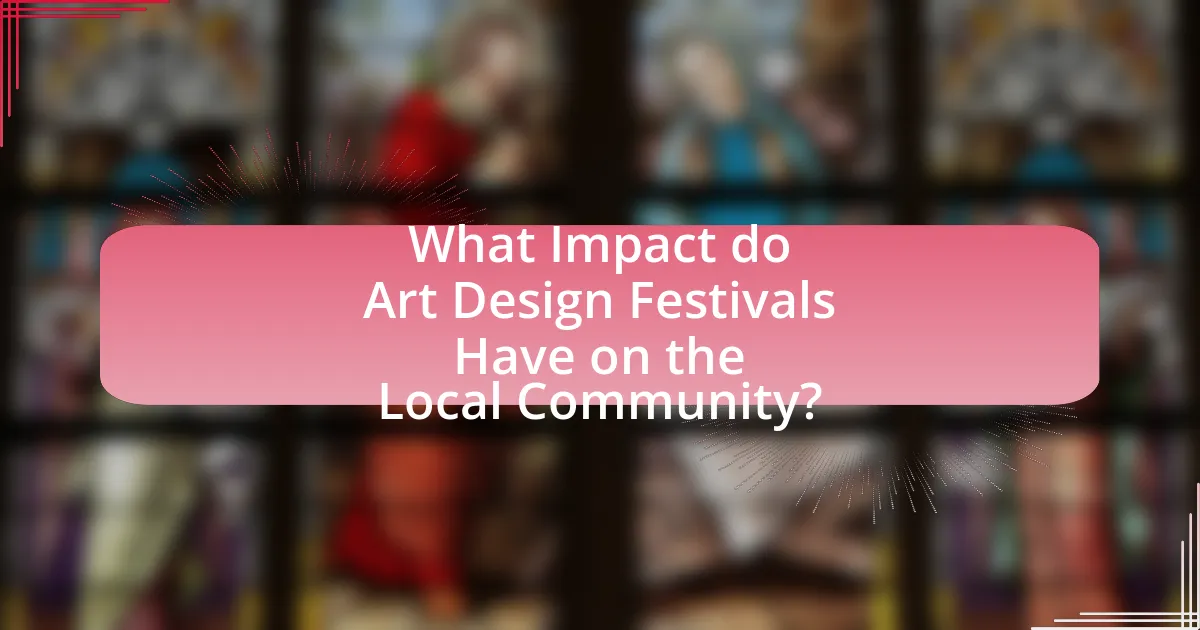
What Impact do Art Design Festivals Have on the Local Community?
Art design festivals significantly enhance the local community by promoting cultural engagement and economic development. These festivals attract visitors, which boosts local businesses, as evidenced by a study from the National Endowment for the Arts indicating that arts events can increase local revenue by up to 30%. Additionally, they provide a platform for local artists to collaborate and showcase their work, fostering a sense of community identity and pride. Research from the University of Pennsylvania highlights that communities with active arts festivals report higher levels of social cohesion and community involvement.
How do these festivals contribute to the local economy?
Art design festivals contribute to the local economy by generating significant revenue through tourism, local business engagement, and job creation. These festivals attract visitors who spend money on accommodations, food, and entertainment, which boosts local businesses. For instance, a study by the National Endowment for the Arts found that arts festivals can increase local economic activity by up to 30% during the event period. Additionally, these festivals often require local vendors and artists, creating temporary and permanent job opportunities, further enhancing economic stability in the community.
What are the financial benefits for local businesses during festivals?
Local businesses experience significant financial benefits during festivals, primarily through increased sales and customer traffic. Festivals attract large crowds, which directly boosts foot traffic to nearby shops and restaurants. For instance, a study by the National Endowment for the Arts found that local businesses can see sales increases of up to 30% during festival periods. Additionally, festivals often encourage collaboration among local artists and businesses, leading to unique offerings that can further enhance sales. This synergy not only elevates the local economy but also fosters community engagement, creating a vibrant atmosphere that attracts both residents and tourists.
How do festivals attract tourism and increase local revenue?
Festivals attract tourism and increase local revenue by creating unique cultural experiences that draw visitors to a region. These events often feature local artists, musicians, and food vendors, which enhances the appeal and encourages spending in the local economy. For instance, a study by the National Endowment for the Arts found that arts festivals can generate significant economic impact, with attendees spending an average of $27 per person on food, lodging, and merchandise. Additionally, festivals can boost hotel occupancy rates and stimulate local businesses, leading to increased tax revenues for the community.
What social benefits arise from community engagement in festivals?
Community engagement in festivals fosters social benefits such as enhanced social cohesion and increased community pride. When individuals participate in festivals, they build relationships and networks, which strengthens community ties. Research indicates that festivals can lead to a 20% increase in community involvement, as they provide a platform for diverse groups to interact and collaborate. Additionally, festivals often celebrate local culture and heritage, which can boost community pride and identity, leading to a more unified and resilient community.
How do festivals promote inclusivity and diversity in the arts?
Festivals promote inclusivity and diversity in the arts by providing platforms for underrepresented artists and cultural expressions. These events often feature a wide range of artistic styles and traditions, allowing diverse voices to be showcased alongside mainstream art. For example, festivals like the Edinburgh Festival Fringe include performances from artists of various backgrounds, ensuring that marginalized communities have visibility. Additionally, many festivals implement outreach programs aimed at engaging local communities, which fosters participation from diverse demographic groups. This approach not only enriches the artistic landscape but also encourages dialogue and understanding among different cultural perspectives.
What role do festivals play in community identity and pride?
Festivals play a crucial role in shaping community identity and pride by serving as platforms for cultural expression and social cohesion. They bring together diverse groups within a community, fostering a sense of belonging and shared values. For instance, events like the Albuquerque International Balloon Fiesta not only celebrate local traditions but also attract visitors, enhancing community visibility and economic growth. Research indicates that participation in community festivals can increase residents’ sense of attachment to their locality, reinforcing pride in their cultural heritage and collective identity.
What are best practices for organizing successful Art Design Festivals?
Best practices for organizing successful Art Design Festivals include establishing clear objectives, engaging local artists, and ensuring effective marketing strategies. Clear objectives guide the festival’s vision and help in measuring success, while engaging local artists fosters community involvement and collaboration, enhancing the festival’s authenticity. Effective marketing strategies, such as utilizing social media and local partnerships, increase visibility and attract a diverse audience. According to a study by the National Endowment for the Arts, festivals that actively involve local artists see a 30% increase in attendance, demonstrating the importance of community engagement in driving success.
How can organizers effectively involve local artists in the planning process?
Organizers can effectively involve local artists in the planning process by establishing collaborative committees that include artists from the outset. This approach ensures that artists contribute their insights and expertise, which can enhance the festival’s artistic vision and community relevance. Research indicates that festivals that actively engage local artists in planning see increased participation and satisfaction among both artists and attendees, as evidenced by the 2019 study published in the Journal of Arts Management, Law, and Society, which found that 75% of festivals reported improved community engagement when local artists were involved in decision-making.
What strategies can be employed to enhance community participation?
To enhance community participation, strategies such as organizing inclusive events, fostering partnerships with local organizations, and utilizing social media for outreach can be employed. Inclusive events, like art design festivals, encourage diverse community members to engage by showcasing local talent and providing interactive experiences. Partnerships with local organizations, such as schools and nonprofits, can amplify outreach efforts and create a sense of shared ownership among community members. Additionally, leveraging social media platforms allows for real-time communication and feedback, increasing visibility and encouraging participation. These strategies have been shown to effectively mobilize community members and strengthen local ties, as evidenced by successful art festivals that have increased attendance and engagement through these methods.










